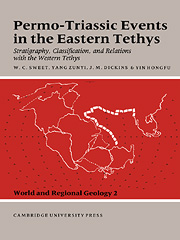 Permo-Triassic Events in the Eastern Tethys
Permo-Triassic Events in the Eastern Tethys Book contents
- Frontmatter
- Contents
- List of contributors
- Preface
- Acknowledgments
- 1 Permo-Triassic events in the eastern Tethys – an overview
- 2 Permo-Triassic boundary relations in South China
- 3 Permo-Triassic boundary of the Indian subcontinent and its intercontinental correlation
- 4 Permo-Triassic boundary on the Indian peninsula
- 5 The Permo-Triassic boundary in the southern and eastern USSR and its international correlation
- 6 Classification and correlation of nonmarine Permo-Triassic boundary in China
- 7 Permian and Triassic events in the continental domains of Mediterranean Europe
- 8 The Permo-Triassic boundary in the Southern Alps (Italy) and in adjacent Periadratic regions
- 9 Permo-Triassic brachiopod successions and events in South China
- 10 Conodont sequences in the Upper Permian and Lower Triassic of South China and the nature of conodont faunal changes at the systemic boundary
- 11 A conodont-based high-resolution biostratigraphy for the Permo-Triassic boundary interval
- 12 The palynofloral succession and palynological events in the Permo-Triassic boundary interval in Israel
- 13 The effects of volcanism on the Permo-Triassic mass extinction in South China
- 14 Geochemical constraints on the Permo-Triassic boundary event in South China
- 15 Permo-Triassic orogenic, paleoclimatic, and eustatic events and their implications for biotic alteration
- 16 Permo-Triassic boundary in Australia and New Zealand
- Index
14 - Geochemical constraints on the Permo-Triassic boundary event in South China
Published online by Cambridge University Press: 12 October 2009
- Frontmatter
- Contents
- List of contributors
- Preface
- Acknowledgments
- 1 Permo-Triassic events in the eastern Tethys – an overview
- 2 Permo-Triassic boundary relations in South China
- 3 Permo-Triassic boundary of the Indian subcontinent and its intercontinental correlation
- 4 Permo-Triassic boundary on the Indian peninsula
- 5 The Permo-Triassic boundary in the southern and eastern USSR and its international correlation
- 6 Classification and correlation of nonmarine Permo-Triassic boundary in China
- 7 Permian and Triassic events in the continental domains of Mediterranean Europe
- 8 The Permo-Triassic boundary in the Southern Alps (Italy) and in adjacent Periadratic regions
- 9 Permo-Triassic brachiopod successions and events in South China
- 10 Conodont sequences in the Upper Permian and Lower Triassic of South China and the nature of conodont faunal changes at the systemic boundary
- 11 A conodont-based high-resolution biostratigraphy for the Permo-Triassic boundary interval
- 12 The palynofloral succession and palynological events in the Permo-Triassic boundary interval in Israel
- 13 The effects of volcanism on the Permo-Triassic mass extinction in South China
- 14 Geochemical constraints on the Permo-Triassic boundary event in South China
- 15 Permo-Triassic orogenic, paleoclimatic, and eustatic events and their implications for biotic alteration
- 16 Permo-Triassic boundary in Australia and New Zealand
- Index
Summary
Introduction
In the 570 Ma since the beginning of the Phanerozoic, five great extinctions of organisms have been recorded, of which the one at the end of the Permian was the most serious. Thus, during the last decade, there has been a growing interest in study of the Permo-Triassic event (Asaro et al., 1982; Alekseev et al., 1983; Sun et al., 1984; Xu et al., 1985; Brandner et al., 1986; Oddone & Vannucii, 1986, 1988; Chai et al., 1987; Clark et al., 1986; He et al., 1987, 1988; Zhou et al., 1987a,b, 1988). Much work has been conducted in the fields of mineralogy, petrology, and isotopic and elemental geochemistry, and on microspherules and shock metamorphosed quartz. Even so, the nature of the mass extinction at the end of the Permian is still quite a controversial issue.
Authors have put forward various models to interpret the Permo-Triassic boundary (P/T) event, among which those favoring volcanic eruption and ones advocating extraterrestrial impact are dominant. Each model, of course, is supported by its own evidence.
Observed and experimentally derived facts that favor the volcanic-eruption model are:
Clays at the P/T boundary exhibit a residual rhyotaxitic structure and contain high-temperature beta-quartz, zircon, and apatite, which are common minerals in acidic intermediate volcanic rocks.
Multilayered clays present above and below the P/T boundary are similar to the boundary clay. Their elemental compositions resemble those of the volcanic ashes in the Triassic of South China.
- Type
- Chapter
- Information
- Permo-Triassic Events in the Eastern TethysStratigraphy Classification and Relations with the Western Tethys, pp. 158 - 168Publisher: Cambridge University PressPrint publication year: 1992
- 2
- Cited by


